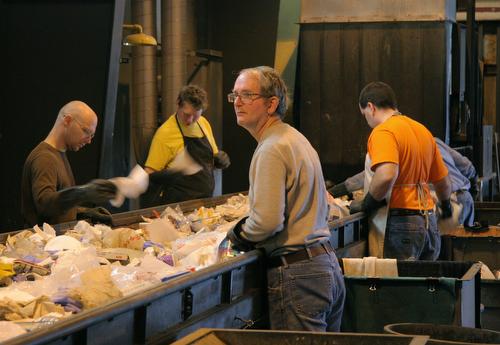Workers help recycle materials to reduce waste at local station
Apr 23, 2007
Last updated on May 12, 2016 at 11:21 a.m.
When students around campus discard a pop can or water bottle into a recycling container at lunch, many do not think about where the recycling goes.
Custodians transport paper, beverage containers and cardboard on a regular basis from campus buildings to the Waste Transport Station, 10 E. St. Mary’s Rd., to be condensed and sold to recycling sites, said Tim Hoss, coordinator of Campus Waste Management. He said the station operates in an efficient way, recycling half of the materials they receive, and transferring the other half to a landfill.
The Waste Reduction Plan began in 1989, the same year Hoss was hired. It includes at least 250 buildings on campus.
Hoss said there are separate pick-up routes for paper and cardboard recyclables, which are transported to the station and are stored in their respective containers. On the other hand, cans and plastic bottles are picked up on trash routes.
Get The Daily Illini in your inbox!
Hoss said light blue bags that line the recycling bins for the beverage containers make it easy for workers at the station to pull the recyclable beverage containers from the trash.
“It’s very easy for us to manage the waste out here, and sort items out of the trash,” Hoss said.
Sorting at the station provides jobs to people who might not otherwise have them, he said.
The workers at the sorting line are from the Developmental Services Center, a non-profit organization that helps developmentally disabled adults in the Champaign and Ford counties.
Hoss said these workers are the only employees at the station who are not part of a union.
“I don’t know if this is the type of job that most of the people who work out here, or in a union job, would want to do,” said Willie Owens, vocational supervisor of the sorting line.
Hoss said that in addition to pulling the blue bags from the trash, the workers also recycle large pieces of scrap metal, cardboard and other materials that are easy to pull from the trash.
He said while the workers are able to separate some of these items, the station prefers to pick the items up on collection routes.
“It makes it easy if the blue bags come down the line with the aluminum still in the bags,” Owens said. “At that point, when there’s a lull or not as much product coming down the line, then we can open up the bags and individually sort them there.”
Owens said that if a blue bag is torn it is only a little bit harder to sort the beverage containers, depending on how much trash is moving down the conveyor belt.
“(A) different collection route for beverage cans would probably cost more to operate yearly than the revenue we bring in,” Hoss said.
“The revenue we bring in is substantial considering we do 80,000 pounds of cans a year,” Hoss said.
The station brings in 98 cents per pound of cans by selling them for recycling, Hoss said.
“Given the capacity of the people employed on the line, I think they do a very good job of recouping a high amount of recyclables in addition to decreasing the general volume or weights of the waste going to the landfill, which cuts costs,” Owens said.
He added that he hopes the decrease will keep the amount of waste in landfills down in the long run.
Since 1994 recycling has kept the station from spending $4.5 million in landfill costs, Hoss said.
“Something we’re doing is working,” he said.






